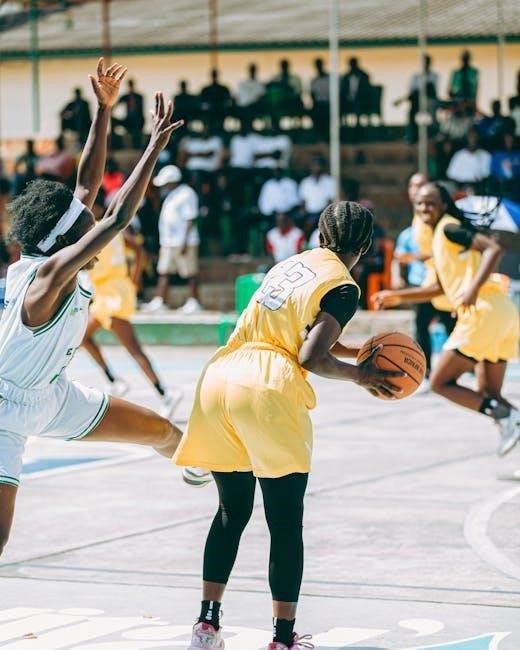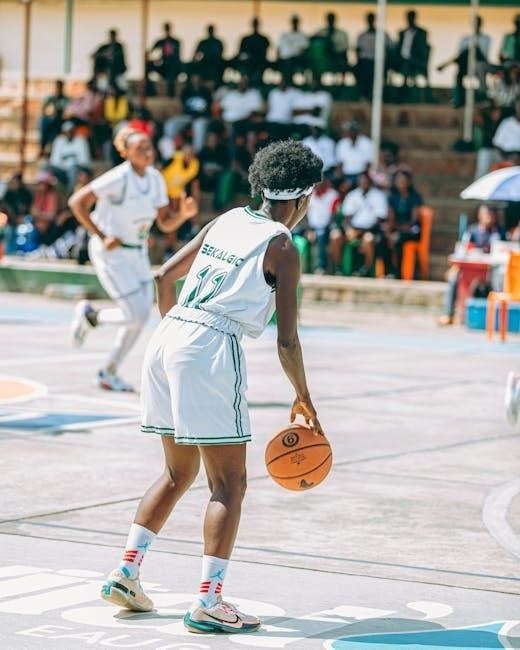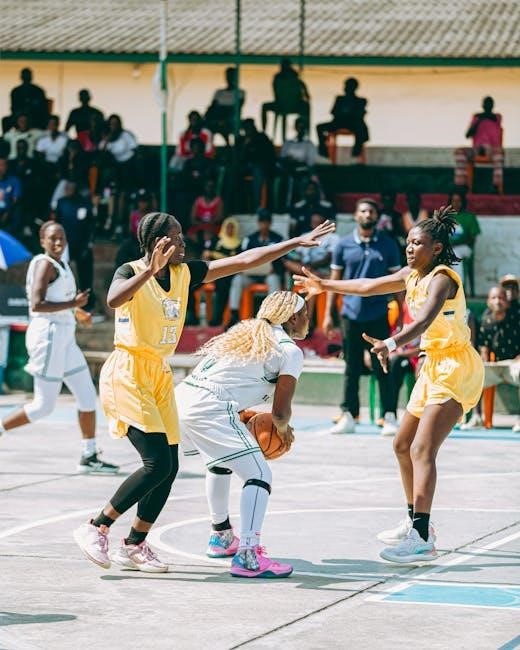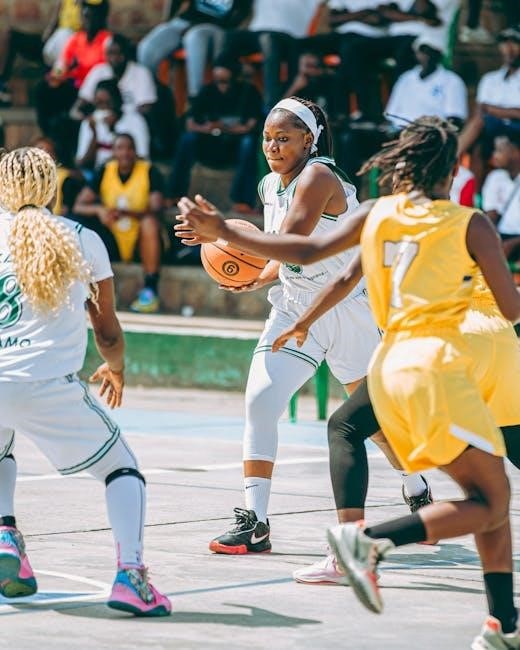Manual basketball is a foundational guide for coaches and players, focusing on core concepts like dribbling, shooting, and teamwork․ It emphasizes discipline, strategy, and skill development, providing a structured approach to the game․ By following drills and training exercises, players can maximize their potential while understanding the importance of life skills like teamwork and perseverance․
What is Manual Basketball?
Manual basketball refers to a structured guide or handbook designed for coaches and players, outlining fundamental skills, strategies, and values essential for the sport․ It serves as a comprehensive resource, detailing drills, techniques, and practices to enhance player development and team performance․ These manuals often include offensive and defensive tactics, skill-specific exercises, and life skills like discipline and teamwork․ They are tailored to help coaches create effective training programs, ensuring players build a strong foundation in basketball․ By focusing on both technical and personal growth, manual basketball provides a holistic approach to the game, making it an invaluable tool for aspiring athletes and coaches alike․
History and Evolution
Manual basketball has evolved significantly since its inception, tracing its roots to the early 20th century when structured coaching began․ Initially, manuals were simple guides focusing on basic skills like dribbling and shooting․ Over time, they expanded to include advanced strategies, drills, and life skills, reflecting the sport’s growth․ The introduction of organized training camps, such as those by USA Basketball, further formalized these resources․ Today, manuals incorporate modern training methods, sports science, and psychological aspects, making them indispensable for coaches and players․ They have become dynamic tools, adapting to the game’s changing demands while preserving its core values․ This evolution highlights the continuous effort to enhance player and team development, ensuring basketball remains a sport of skill, strategy, and personal growth․

Importance of Coaching Manuals
Coaching manuals provide structure, strategy, and skill development frameworks, ensuring consistency and effectiveness in training․ They standardize techniques and serve as invaluable resources for coaches at all levels․
Role in Player Development
Coaching manuals play a pivotal role in player development by providing structured training programs, skill-specific drills, and strategies to enhance technical and tactical abilities․ They help players master fundamental skills like dribbling, shooting, and passing through systematic practice plans․ Manuals also emphasize the importance of discipline, teamwork, and communication, fostering holistic growth․ By offering clear guidelines, coaches can tailor training to individual and team needs, ensuring progressive improvement․ These resources often include exercises to improve physical fitness, mental focus, and game awareness, preparing athletes for competitive scenarios․ Additionally, manuals highlight life skills such as perseverance and problem-solving, which are essential for both on-court success and personal development․ Regular use of these materials ensures players build a strong foundation, leading to long-term success in basketball and beyond․ The structured approach of coaching manuals makes them indispensable for effective player development at all levels of the game․
Benefits for Coaches
Coaching manuals provide coaches with a structured approach to teaching basketball, ensuring they are well-prepared for practices and games․ These resources offer detailed drills, strategies, and techniques to enhance player development while refining a coach’s ability to communicate effectively․ Manuals also serve as a reference for organizing training sessions, helping coaches stay updated on the latest methods and philosophies in basketball․ They provide a clear framework for improving technical skills, tactical awareness, and teamwork among players․ Additionally, manuals often include tips for fostering discipline, resilience, and sportsmanship, which are essential for building a cohesive and motivated team․ By relying on coaching manuals, coaches can create a positive and productive learning environment, ensuring their players reach their full potential while fostering a love for the game․

Skills Development
Manual basketball emphasizes a structured approach to improving essential skills through focused drills and consistent practice, ensuring players master the fundamentals effectively․
Dribbling
Dribbling is a fundamental skill in basketball, requiring hand-eye coordination, balance, and practice․ A good dribbler can control the ball effectively, creating scoring opportunities and maintaining possession․ Start with stationary drills, focusing on figure-eight and crossovers to improve dexterity․ Progress to moving drills, such as zigzag runs and around-the-world exercises, to build speed and control․ Emphasize keeping the head up to stay aware of teammates and opponents․ Incorporate game-like scenarios to apply skills under pressure․ Consistent practice and structured drills are essential for mastery, helping players confidently navigate the court and make decisive plays․ Proper footwork and body positioning also enhance dribbling efficiency, allowing players to change direction quickly and maintain control in tight spaces․
Shooting
Shooting is a critical skill in basketball, requiring precision, balance, and consistent practice․ Proper technique involves squaring the feet to the basket, aligning the shooting shoulder with the hoop, and using the fingertips to release the ball․ Start with stationary shooting drills, such as jump shots and free throws, to build accuracy․ Progress to moving shots, including catch-and-shoot and off-the-dribble scenarios, to simulate game situations․ Emphasize follow-through and maintaining a high arc for better success․ Incorporate shooting games and competitions to make practice engaging․ Players should practice from various spots on the court, focusing on footwork and balance to create space․ Consistent repetition and focused practice are key to mastering this essential skill, helping players become reliable scorers and contributors to their team’s success․
Passing
Passing is a fundamental skill in basketball, essential for maintaining possession and creating scoring opportunities․ It requires accuracy, vision, and teamwork․ Start with basic drills like chest passes and bounce passes, focusing on proper grip, footwork, and follow-through․ Players should practice passing with both hands, developing versatility․ Partner passing drills can improve timing and accuracy, while team drills simulate game situations, such as moving the ball up the court or setting up plays․ Emphasize the importance of reading defenses and making smart decisions․ Incorporate competitive exercises, like passing relays, to build speed and precision․ Advanced techniques include no-look and skip passes to confuse defenders․ Consistent practice and game-like scenarios help players excel in delivering the ball effectively, enhancing overall team performance and offensive flow․ Passing is not just a skill but a crucial aspect of teamwork and strategic play․

Offensive Strategies
Offensive strategies in manual basketball combine skill execution, teamwork, and adaptability․ Coaches design plays to exploit defensive weaknesses, emphasizing ball movement, player positioning, and scoring opportunities․ Effective strategies enhance competitiveness and consistency․
Basic Plays
Basic plays are the cornerstone of offensive success in basketball, providing structured strategies for players to execute effectively․ These plays are designed to create scoring opportunities by exploiting defensive weaknesses․ Common examples include the pick-and-roll, give-and-go, and isolation plays․ Coaches often use these plays to simplify decision-making for players, especially at developmental stages․ Proper execution of basic plays relies on precise ball movement, timing, and player positioning․ They also foster teamwork and accountability, as each player has a defined role․ Mastery of these plays builds a solid foundation for more advanced tactics and enhances overall offensive efficiency․ Regular practice drills, such as half-court scenarios, help players refine their skills and adapt to game situations․ By focusing on fundamentals, basic plays ensure consistency and reliability in offensive performance․

Advanced Tactics
Advanced tactics in basketball involve complex strategies designed to outmaneuver opponents and create high-percentage scoring opportunities․ These tactics often include sophisticated ball movement, player positioning, and coordinated teamwork․ Examples of advanced tactics include post-up plays, backdoor cuts, and perimeter screening actions․ Coaches may also employ mismatch exploitation, where players are positioned to face weaker defenders․ Additionally, advanced tactics might involve manipulating defensive alignments through clever spacing and timing․ These strategies require a high level of skill, game awareness, and communication among players․ They are typically introduced at higher levels of competition, where players have mastered fundamental skills․ Advanced tactics also emphasize adaptability, allowing teams to adjust their approach based on defensive reactions․ Mastering these strategies enhances a team’s versatility and ability to compete against elite opponents, making them a crucial part of a coach’s playbook․

Defensive Techniques
Defensive techniques involve strategies to disrupt opponents’ offenses, such as man-to-man and zone defense․ Players use positioning, anticipation, and teamwork to protect the basket and force turnovers effectively․
Man-to-Man
Man-to-man defense is a fundamental defensive strategy where each player guards a specific opponent․ This approach emphasizes individual responsibility and close coverage to disrupt the opponent’s offensive flow․ Players must stay in front of their assigned player, contesting dribbles and shots effectively․ Proper positioning, footwork, and anticipation are critical to success․ Coaches often stress the importance of staying low, using active hands, and maintaining eye contact with the ball handler․ Communication among teammates is vital to switch assignments when necessary and provide help defense․ This strategy requires quick reactions and agility, making it ideal for teams with athletic players․ Man-to-man defense encourages accountability and forces opponents into difficult shots or turnovers․ It is a cornerstone of basketball defense, teaching players discipline and spatial awareness while fostering a competitive mindset․
Zone Defense
Zone defense is a strategic approach where players defend specific areas of the court rather than individual opponents․ This method allows teams to protect high-scoring zones, such as the paint, while forcing opponents to take low-percentage shots from the perimeter․ Players position themselves in designated zones, working together to anticipate and intercept passes or driving lanes․ Zone defense is particularly effective against teams with strong post players or when matchups create defensive disadvantages․ However, it requires precise communication and rotation to avoid gaps in coverage․ Coaches often emphasize the importance of staying disciplined, contesting shooters, and rebounding collectively․ Zone defense can be adapted into various setups, such as a 2-3 or 3-2 zone, depending on the team’s strengths and the opponent’s weaknesses․ Proper execution enhances defensive efficiency and limits scoring opportunities, making it a versatile and impactful strategy in basketball․

Drills and Training Exercises
Drills and training exercises are essential for improving core basketball skills like dribbling, shooting, and passing․ They enhance teamwork, physical fitness, and game readiness, ensuring players excel on the court․
Warm-Up Routines
A proper warm-up is crucial for preparing players physically and mentally․ It typically includes light cardio, stretching, and dynamic movements to prevent injuries and enhance performance․ Coaches often incorporate drills like high knees, butt kicks, and arm circles to boost circulation and flexibility․ Ball handling exercises, such as dribbling through cones, are also common to improve coordination․ The warm-up should gradually increase intensity, transitioning from basic movements to more complex basketball-specific actions․ This structured approach ensures players are ready to engage fully in practice or competition, reducing the risk of injury and improving overall readiness․ A well-designed warm-up routine sets the tone for a productive session, fostering focus and teamwork from the start․
Skill-Specific Drills
Skill-specific drills are designed to enhance individual basketball abilities, focusing on areas like dribbling, shooting, and passing․ These exercises are tailored to improve technique, accuracy, and game readiness․ For example, dribbling drills such as cone weaving or figure-eight exercises help refine ball control and hand-eye coordination․ Shooting drills, like spot-up shots or off-the-dribble jumpers, aim to boost accuracy and confidence․ Passing drills, such as chest passes, bounce passes, and outlet passes, emphasize precision and decision-making․ Coaches often incorporate dynamic movements and game-like scenarios to simulate real-game conditions․ These drills not only improve physical skills but also mental focus and adaptability․ By consistently practicing skill-specific exercises, players develop a stronger foundation, enabling them to perform effectively during competitions․ This structured approach ensures continuous improvement and prepares athletes for the demands of the game․

Training Camps
Training camps, like USA Basketball’s U16 National Team camp, offer intensive skill development and strategic training․ They focus on refining techniques, building teamwork, and preparing athletes for competitive play․

USA Basketball Men’s U16 National Team
The USA Basketball Men’s U16 National Team represents the pinnacle of youth basketball talent in the United States․ Each year, 36 top athletes are selected to participate in a training camp held at the U․S․ Olympic & Paralympic Training Center․ This camp is a rigorous evaluation process where players showcase their skills and compete for a spot on the final 12-man roster․ The team is prepared by experienced coaches who focus on developing both individual and team skills, emphasizing tactical awareness, physical conditioning, and mental toughness․ The ultimate goal is to compete in international tournaments, such as the FIBA Americas Championship, and bring home gold for the United States․ The program not only highlights elite basketball talent but also serves as a platform for nurturing future leaders in the sport․
Selection Process
The selection process for the USA Basketball Men’s U16 National Team is rigorous and competitive․ Athletes are identified through a combination of scouting, recommendations, and performances in regional camps and tournaments․ A pool of top talent is invited to participate in an initial training camp, where coaches evaluate skills, teamwork, and leadership abilities․ The process includes drills, scrimmages, and interviews to assess mental and physical readiness․ A committee reviews player performances, focusing on versatility, work ethic, and potential to contribute to the team․ The final roster is announced after careful deliberation, ensuring a balanced mix of skills and positions․ Selected athletes are notified and prepared for international competition, representing the United States at the highest level of youth basketball․

Life Skills and Values
Manual basketball emphasizes discipline, teamwork, and sportsmanship, fostering essential life skills like communication, resilience, and accountability․ These values enhance both basketball success and personal growth, shaping well-rounded athletes․
Discipline
Discipline is a cornerstone of success in basketball, fostering a culture of accountability and responsibility․ It involves adhering to rules, respecting teammates, and maintaining focus during practices and games․ Coaches play a pivotal role in instilling discipline by setting clear expectations and promoting a structured environment․ Players who embrace discipline develop better work ethic, leading to improved performance and decision-making on the court․ Discipline also extends beyond basketball, teaching athletes valuable life lessons such as time management and self-control․ Through consistent practice and accountability, discipline becomes a habit, empowering players to overcome challenges and achieve their goals both individually and as part of a team․ By prioritizing discipline, athletes build a strong foundation for long-term success in basketball and beyond․
Teamwork
Teamwork is the backbone of basketball, emphasizing collaboration and unity among players․ It fosters trust, communication, and mutual respect, essential for achieving common goals․ Coaches play a crucial role in nurturing teamwork by designing drills that promote coordination and collective effort․ Players learn to rely on each other’s strengths while compensating for weaknesses, creating a cohesive unit․ Teamwork extends beyond the court, teaching athletes the value of collaboration in all aspects of life․ By working together, players develop problem-solving skills, adaptability, and a shared sense of responsibility․ Effective teamwork not only enhances performance but also builds lasting bonds among teammates, creating a positive and supportive environment․ Ultimately, teamwork transforms individual talent into a powerful collective force, driving success in basketball and beyond․